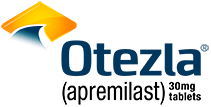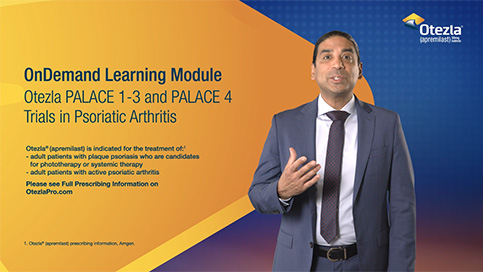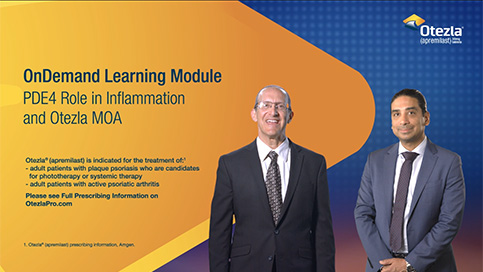Discuss the Safety Data of an Established Oral PDE4 Inhibitor
CHAPTER 1
Dr. Feldman: Hi, my name is Dr. Steven Feldman. I am a dermatologist and editor of the Journal of Dermatological Treatment.
Dr. Majjhoo: Hi, My name is Dr. Amar Majjhoo. I am a rheumatologist at Shores Rheumatology. Welcome to this learning module.
Dr. Feldman: Safety data is an important consideration when evaluating treatment plans for patients with psoriasis and psoriatic arthritis.
Dr. Majjhoo: In this 4-chapter learning module, Dr. Feldman and I will discuss Otezla®, apremilast, which was approved in 2014 and is an established oral inhibitor of phosphodiesterase 4, or PDE4. Dr. Feldman: In this first chapter, I will review the efficacy and safety data of Otezla from the ESTEEM trials in patients with moderate to severe psoriasis. Then, Dr. Majjhoo will present data from the PALACE clinical trials in patients with psoriatic arthritis. Dr. Majjhoo: After watching both clinical trial chapters, you will unlock 2 other short chapters, with Dr. Feldman and I highlighting the combined safety data from the ESTEEM and PALACE trials and distinct mechanism of action of Otezla.
Dr. Feldman: Thank you, Dr. Majjhoo. As you know, Otezla is the only oral therapy indicated for plaque psoriasis and psoriatic arthritis. Before we delve into the clinical data in more detail, let’s briefly review indications and contraindications. 1,2 Otezla is an oral nonbiologic PDE4 inhibitor indicated for the treatment of adult patients with plaque psoriasis who are candidates for phototherapy or systemic therapy. Otezla is also indicated for adult patients with active psoriatic arthritis. 1 Otezla is contraindicated in patients with a known hypersensitivity to apremilast or to any of the excipients in the formulation. 1
References: 1. Otezla [package insert]. Thousand Oaks, CA: Amgen, Inc. 2. Data on file, Amgen.
Dr. Feldman: We will begin today’s module with ESTEEM clinical data. Otezla was evaluated in 2 double-blind, placebo-controlled trials of similar design, known as ESTEEM 1 and 2. A total of 1,257 patients with moderate to severe plaque psoriasis were included to receive either Otezla or placebo. 1-3 These adult patients had psoriasis for at least 12 months. They were also candidates for phototherapy or systemic therapy. Prior systemic therapy was permitted. 1-4 Selected inclusion criteria included a static Physician’s Global Assessment, or sPGA, of at least 3, indicative of moderate to severe disease; body surface area, or BSA, involvement of at least 10%; and a Psoriasis Area and Severity Index, or PASI, score of at least 12. 1-3
References: 1. Otezla [package insert]. Thousand Oaks, CA: Amgen, Inc. 2. Papp, et al. J Am Acad Dermatol. 2015;73:37-49.
3. Paul, et al. Br J Dermatol. 2015;173:1387-1399. 4. Data on file, Amgen.
Dr. Feldman: The first 16 weeks of these trials were placebo-controlled. Patients were randomized 2 to 1 to either Otezla 30 mg twice daily or placebo. 1-3 The primary endpoint was the proportion of patients achieving PASI-75, or 75% clearer skin, at
week 16. 1-3 Otezla achieved the primary endpoint in the ESTEEM trials. Otezla treatment resulted in significantly more patients achieving a PASI-75 response at week 16 compared with placebo, in both ESTEEM 1 and ESTEEM 2. 1
References: 1. Otezla [package insert]. Thousand Oaks, CA: Amgen, Inc. 2. Papp, et al. J Am Acad Dermatol. 2015;73:37-49.
3. Paul, et al. Br J Dermatol. 2015;173:1387-1399.
Dr. Feldman: Otezla has an established safety profile. Adverse reactions reported in at least 5% of patients on Otezla up to
week 16 were diarrhea, nausea, upper respiratory tract infection, tension headache, and headache. The proportion of patients with psoriasis who discontinued treatment due to any adverse reaction was roughly 6% for Otezla-treated patients and 4% for placebo-treated patients. Dr. Feldman: In addition to the most common adverse reactions, selected marked abnormalities in laboratory parameters were assessed in the ESTEEM trials. It is critical to note that the prescribing information for Otezla has no requirement for baseline or routine lab monitoring. Dr. Feldman: The placebo-controlled phase ended at week 16. All patients originally assigned to placebo were transitioned to receive Otezla. At week 32, based on clinical response, some patients originally randomized to the Otezla arm were re-randomized to receive Otezla or placebo; those re-randomized to placebo restarted Otezla at loss of response, but no later than week 52. 1,2 After week 52, patients entering a long-term extension phase could be treated through 5 years. Let’s look at the long-term safety results from this phase. 1,2
References: 1. Papp, et al. J Am Acad Dermatol. 2015;73:37-49. 2. Paul, et al. Br J Dermatol. 2015;173:1387-1399.
Dr. Feldman: Otezla demonstrated a consistent long-term safety profile through 5 years of exposure in the ESTEEM clinical studies, with common adverse reactions being diarrhea, nausea, upper respiratory tract infection, nasopharyngitis, tension headache, and headache. The Otezla exposure period in each column includes all data while patients were exposed to Otezla during the interval, relative to the start of Otezla. At the bottom of the page, you can notice the discontinuation rates due to adverse reactions during each year interval. Later in this module, Dr. Majjhoo and I will dive deeper into these most common adverse reactions from the combined ESTEEM and PALACE studies in patients with moderate to severe psoriasis and psoriatic arthritis. We are now toward the end of the chapter. Before I summarize the key take-home messages, let’s review the full important safety information.
VO: Warnings and Precautions: Hypersensitivity: Hypersensitivity reactions, including angioedema and anaphylaxis, have been reported during post marketing surveillance. If signs or symptoms of serious hypersensitivity reactions occur, discontinue Otezla and institute appropriate therapy. Diarrhea, Nausea, and Vomiting: Cases of severe diarrhea, nausea, and vomiting were associated with the use of Otezla. Most events occurred within the first few weeks of treatment. In some cases, patients were hospitalized. Patients 65 years of age or older and patients taking medications that can lead to volume depletion or hypotension may be at a higher risk of complications from severe diarrhea, nausea, or vomiting. Monitor patients who are more susceptible to complications of diarrhea or vomiting; advise patients to contact their healthcare provider. Consider Otezla dose reduction or suspension if patients develop severe diarrhea, nausea, or vomiting. Depression: Carefully weigh the risks and benefits of treatment with Otezla for patients with a history of depression and/or suicidal thoughts or behavior, or in patients who develop such symptoms while on Otezla. Patients, caregivers, and families should be advised of the need to be alert for the emergence or worsening of depression, suicidal thoughts or other mood changes, and they should contact their healthcare provider if such changes occur. Plaque Psoriasis: Treatment with Otezla is associated with an increase in depression. During clinical trials in patients with moderate to severe plaque psoriasis, 1.3% of patients reported depression compared to 0.4% on placebo. Depression was reported as serious in 0.1% of patients exposed to Otezla, compared to none in placebo-treated patients. Suicidal behavior was observed in 0.1% of patients on Otezla, compared to 0.2% on placebo. One patient treated with Otezla attempted suicide; one patient on placebo committed suicide. Psoriatic Arthritis: Treatment with Otezla is associated with an increase in depression. During clinical trials, 1.0% reported depression or depressed mood compared to 0.8% treated with placebo. Suicidal ideation and behavior was observed in 0.2% of patients on Otezla, compared to none in placebo-treated patients. Depression was reported as serious in 0.2% of patients exposed to Otezla, compared to none in placebo-treated patients. Two patients who received placebo committed suicide compared to none on Otezla. Weight Decrease: Monitor body weight regularly; evaluate unexplained or clinically significant weight loss, and consider discontinuation of Otezla. Plaque Psoriasis: Body weight loss of 5 to 10% occurred in 12% of patients with moderate to severe plaque psoriasis treated with Otezla and in 5% of patients treated with placebo. Body weight loss of 10% or more occurred in 2% of patients treated with Otezla compared to 1% of patients treated with placebo. Psoriatic Arthritis: Body weight loss of 5 to 10% was reported in 10% of patients taking Otezla and in 3.3% of patients taking placebo. Drug Interactions: Apremilast exposure was decreased when Otezla was co-administered with rifampin, a strong CYP450 enzyme inducer; loss of Otezla efficacy may occur. Concomitant use of Otezla with CYP450 enzyme inducers (for example, rifampin, phenobarbital, carbamazepine, phenytoin) is not recommended. Adverse Reactions: Plaque Psoriasis: The most common adverse reactions (5% or more) are diarrhea, nausea, upper respiratory tract infection, and headache, including tension headache. Overall, the safety profile of Otezla in patients with mild to moderate plaque psoriasis was consistent with the safety profile previously established in adult patients with moderate to severe plaque psoriasis. Psoriatic Arthritis: The most common adverse reactions (5% or more) are diarrhea, nausea, and headache. Use in Specific Populations: Otezla has not been studied in pregnant women. Advise pregnant women of the potential risk of fetal loss. Please see the full Prescribing Information for Otezla provided on OtezlaPro.com.
Dr. Feldman: In this chapter, we reviewed two pivotal trials involving almost 1,200 patients with moderate to severe psoriasis who were exposed to Otezla, representing about 2,100 patient-years of exposure. 1,2 Otezla is an oral therapy with established safety data for up to 5 years. 1,2 Importantly, the prescribing information for Otezla has no requirement for baseline or routine lab monitoring. 1
References: 1. Otezla [package insert]. Thousand Oaks, CA: Amgen, Inc. 2. Data on file, Amgen.
Dr. Feldman: Thank you for watching. Now, please join Dr. Majjhoo to learn more about Otezla clinical data in patients with psoriatic arthritis. At the end of this chapter, you will unlock 2 short chapters in which Dr. Majjhoo and I will discuss the combined safety data from the ESTEEM and PALACE trials and mechanism of action of Otezla.
CHAPTER 2
Dr. Majjhoo: Hi again. I am Dr. Majjhoo and I am very excited to introduce you to the PALACE 1-3 and PALACE 4 trials in psoriatic arthritis. Dr. Majjhoo: Otezla’s indication for adults with active psoriatic arthritis was based on 3 multicenter, randomized, placebo-controlled phase 3 pivotal studies: PALACE 1, 2, and 3. 1-3 An additional phase 3 study, PALACE 4, evaluated the efficacy and safety of Otezla in disease-modifying antirheumatic drug, or DMARD-naïve adult patients with active psoriatic arthritis. 4 All 4 studies enrolled adult patients with active psoriatic arthritis. Patients had this diagnosis for at least 6 months in the
PALACE 1-3 trials and at least 3 months in the PALACE 4 trial. Active psoriatic arthritis was defined as having at least 3 swollen joints and at least 3 tender joints. 1,4,5 In PALACE 1-3, these patients experienced symptoms despite prior or current DMARD therapy. Patients who failed more than 3 small-molecule agents or biologics for psoriatic arthritis or who failed more than 1 biologic tumor necrosis factor, or TNF, blocker were excluded from the studies. 1 In PALACE 4, no prior treatment with DMARDs was allowed. In these 4 studies, low-dose oral corticosteroids and/or nonsteroidal anti-inflammatory drugs, or NSAIDs, were allowed as concomitant therapies. 1,4
References: 1. Otezla [package insert]. Thousand Oaks, CA: Amgen, Inc. 2. Cutolo, et al. J Rheumatol. 2016;43:1724-1734.
3. Edwards, et al. Ann Rheum Dis. 2016;75:1065-1073. 4. Wells, et al. Rheumatology (Oxford). 2018;57:1253-1263. 5. Kavanaugh, et al. Arthritis Res Ther. 2019;21:118.
Dr. Majjhoo: All 4 studies had a similar design. A total number of 2,020 patients were involved in these trials. During the
placebo-controlled phase, patients were randomized to receive Otezla 20 mg or 30 mg twice daily or placebo. The primary endpoint was the percentage of patients achieving an American College of Rheumatology criteria for 20% improvement, or ACR20 response, at week 16. 1-3 Significantly more patients receiving Otezla achieved ACR20 response compared with the placebo groups in PALACE 1-3 clinical trials. 1 Significance was also seen in PALACE 4 trial in csDMARD-naïve patients. 3
References: 1. Otezla [package insert]. Thousand Oaks, CA: Amgen, Inc. 2. Kavanaugh, et al. Arthritis Res Ther. 2019;21:118.
3. Wells, et al. Rheumatology (Oxford). 2018;57:1253-1263.
Dr. Majjhoo: Otezla has an established safety profile. In the PALACE 1-3 trials, the most common adverse reactions in at least 5% of patients receiving Otezla through week 16 were:diarrhea, nausea, and headache. 1 The proportion of patients with psoriatic arthritis who discontinued treatment due to any adverse reactions was 4.6% for Otezla treated patients and 1.2% for placebo treated patients. 1
Reference: 1. Otezla [package insert]. Thousand Oaks, CA: Amgen, Inc.
Dr. Majjhoo: In the PALACE 4 trial, the most common adverse reactions were diarrhea nausea and headache. 1 The majority of diarrhea and nausea generally occurred within the first 2 weeks of treatment and tended to resolve within 4 weeks with continued dosing. 2 Postmarketingreports of severe diarrhea, nausea, and vomiting have been associated with the use of Otezla. In some cases, patients were hospitalized. Monitor patients who are more susceptible to complications of diarrhea or vomiting. 3
References: 1. Data on file, Amgen. 2. Wells, et al. Rheumatology (Oxford). 2018;57:1253-1263. 3. Otezla [package insert]. Thousand Oaks, CA: Amgen, Inc.
Dr. Majjhoo: In addition to most common adverse reactions, selected marked abnormalities in laboratory parameters were assessed in the PALACE 1-3 trials. 1 It is critical to note that the prescribing information for Otezla has no requirement for baseline or routine lab monitoring. 2
References: 1. Data on file, Amgen. 2. Otezla [package insert]. Thousand Oaks, CA: Amgen, Inc.
Dr. Majjhoo: After the initial 16 weeks, these trials continued. All patients in the placebo group whose tender or swollen joint counts had not improved by at least 20% at week 16 were re-randomized to one of the Otezla treatment groups. 1-3 At week 24, patients entered the blinded active treatment phase, and all remaining placebo patients were re-randomized to active treatment with Otezla. 1-3 After week 52, patients entering a long-term extension phase could be treated through 5 years. Let’s discuss the safety results observed through 5 years in more detail. 2,3
References: 1. Otezla [package insert]. Thousand Oaks, CA: Amgen, Inc. 2. Kavanaugh, et al. Arthritis Res Ther. 2019;21:118.
3. Wells, et al. Rheumatology (Oxford). 2018;57:1253-1263.
Dr. Majjhoo: Otezla demonstrated a consistent long-term safety profile through 5 years of exposure in the PALACE 1-3 clinical studies, with common adverse reactions being diarrhea, nausea, headache, upper respiratory tract infection, nasopharyngitis, vomiting, and upper abdominal pain. 1,2 The Otezla exposure period in each column includes all data while patients were exposed to Otezla during the interval, relative to the start of Otezla. 1,2 At the bottom of the page, you can notice the discontinuation rates due to adverse reactions during each year interval. 1
References: 1. Data on file, Amgen. 2. Kavanaugh, et al. Arthritis Res Ther. 2019;21:118.
Dr. Majjhoo: In this section, I have discussed 4 clinical trials involving almost 1,000 patients with psoriatic arthritis who were exposed to Otezla 30 mg twice daily, representing about 2,900 patient-years of exposure. 1,2,4 Otezla is an oral therapy with established and consistent safety data for up to 5 years. 1,3,4 The prescribing information for Otezla has no requirement for baseline or routine lab monitoring. 1
References: 1. Otezla [package insert]. Thousand Oaks, CA: Amgen, Inc. 2. Wells, et al. Rheumatology (Oxford). 2018;57:1253-1263. 3. Kavanaugh, et al. Arthritis Res Ther. 2019;21:118. 4. Data on file, Amgen.
Dr. Majjhoo: Thank you for watching. Now you have access to watch Dr. Feldman and I introducing the combined 5-year safety data from both ESTEEM and PALACE studies, and the distinct mechanism of action of Otezla. Click on either option to learn more.
CHAPTER 3
Dr. Feldman: Hi again, and thank you for joining Dr. Majjhoo and myself in this chapter to talk about the role of PDE4 in inflammation and the distinct mechanism of action of Otezla. Dr. Majjhoo: Indeed, Dr. Feldman. So, let’s take a deeper look at how Otezla works in the cells of our patients with moderate to severe psoriasis and psoriatic arthritis.
Dr. Majjhoo: In psoriasis and psoriatic arthritis, dysregulation of multiple inflammatory mediators occurs in immune cells, skin cells, and joint cells. The cascade of aberrant immune signaling leads to inflammation and underlies the clinical signs in these 2 diseases. Dr. Feldman, can you tell us how systemic drugs work in inflammation?
Reference: Schafer. Biochem Pharmacol. 2012;83:1583-1590.
Dr. Feldman: Sure. Biologics are 1 category of systemic drugs targeting extracellular inflammatory cytokines.
Reference: Schafer. Biochem Pharmacol. 2012;83:1583-1590.
Dr. Feldman: Another category is nonbiologic systemic drugs that disrupt the inflammatory cascade. Some of these target intracellular second messengers that influence the production of cytokines. A key second messenger is cyclic adenosine monophosphate, or cAMP, which has been shown to relay signals to intracellular mediators that regulate the production of cytokines in inflammatory cells.
Reference: Schafer. Biochem Pharmacol. 2012;83:1583-1590.
Dr. Feldman: High intracellular cAMP concentration dampens pro-inflammatory signaling. On the other hand, low cAMP concentration boosts inflammatory signaling. Hence, the level of cAMP within a cell modulates the expression of pro-inflammatory and anti-inflammatory mediators.
Reference: Schafer. Biochem Pharmacol. 2012;83:1583-1590.
Dr. Feldman: Dr Majjhoo, can you share some insights on what regulates the intracellular cAMP level?
Dr. Majjhoo: Great question. A crucial molecule is PDE4, which has been shown to play an important role in inflammation that can lead to psoriasis and psoriatic arthritis.
Reference: Schafer. Biochem Pharmacol. 2012;83:1583-1590.
Dr. Majjhoo: PDE4 is a family of intracellular enzymes best known to selectively degrade cAMP to adenosine monophosphate, or AMP, and lower intracellular cAMP levels in immune cells, skin cells, and joint cells.
Reference: Schafer. Biochem Pharmacol. 2012;83:1583-1590.
Dr. Majjhoo: By decreasing intracellular cAMP, PDE4 increases the production of pro-inflammatory mediators and decreases the production of anti-inflammatory mediators. Therefore, PDE4 is a critical target to indirectly control cAMP level and ultimately inflammation.
Reference: Schafer. Biochem Pharmacol. 2012;83:1583-1590.
Dr. Feldman: Great point. Let me introduce you to a key PDE4 inhibitor: apremilast, an oral nonbiologic small-molecule inhibitor of PDE4 that works intracellularly and is thought to regulate the production of inflammatory mediators. 1-3 We have known apremilast as Otezla since its approval in 2014, first for the treatment of adult patients with active psoriatic arthritis, then for the treatment of adult patients with moderate to severe psoriasis. 1
References: 1. Otezla [package insert]. Thousand Oaks, CA: Amgen, Inc. 2. Menter, et al. J Am Acad Dermatol. 2020;82:1445-1486. 3. Schafer. Biochem Pharmacol. 2012;83:1583-1590.
Dr. Feldman: By inhibiting PDE4, apremilast can elevate intracellular cAMP levels. 1 Based on exploratory biomarker studies of ESTEEM 2 and PALACE 1, PDE4 inhibition has been shown to dampen the production of certain pro-inflammatory mediators and increase the production of anti-inflammatory mediators, leading to an anti-inflammatory outcome, which Dr. Majjhoo will dive into next. 2,3 The specific mechanism by which Otezla exerts its therapeutic action is not well-defined. 4
References: 1. Schafer. Biochem Pharmacol. 2012;83:1583-1590. 2. Schafer, et al. J Immun Res. 2015;2015:906349. 3. Garcet,
et al. J Allergy Clin Immunol. 2018. 4. Otezla [package insert]. Thousand Oaks, CA: Amgen, Inc.
Dr. Majjhoo: That’s right. In an exploratory biomarker sub-study of PALACE 1, the impact of Otezla on inflammatory markers was evaluated in patients with psoriatic arthritis.
Reference: Schafer, et al. J Immun Res. 2015;2015:906349.
Dr. Majjhoo: Otezla increased the level of anti-inflammatory mediators, such as interleukin-10, or IL-10, and decreased the level of pro-inflammatory mediators, such as TNF-alpha, IL-17A, and IL-23.
Reference: Schafer, et al. J Immun Res. 2015;2015:906349.
Dr. Feldman: Similarly, an exploratory biomarker sub-study of ESTEEM 2 also evaluated the impact of Otezla on inflammatory biomarkers in patients with psoriasis. 1
Reference: 1. Garcet, et al. J Allergy Clin Immunol. 2018;142:1010-1013.e6.
Dr. Feldman: In this study, Otezla decreased pro-inflammatory mediators IL-17F, IL-17A, IL-22, and TNF-alpha. 1 Dr. Majjhoo: Please note, these biomarker analyses were exploratory and not designed to detect changes in biomarker levels or the relationship between biomarker change and clinical outcome. 2
References: 1. Garcet, et al. J Allergy Clin Immunol. 2018;142:1010-1013.e6. 2. Data on file, Amgen.
Dr. Feldman: In conclusion, Otezla is the first and only inhibitor of PDE4 indicated for the treatment of adult patients with active psoriatic arthritis or plaque psoriasis. 1,2
References: 1. Otezla [package insert]. Thousand Oaks, CA: Amgen, Inc. 2. Data on file, Amgen.
Dr. Majjhoo: It’s important to know that Otezla is an established oral therapy approved in 2014 that has been helping patients with active psoriatic arthritis or moderate to severe psoriasis for more than 6 years.
Dr. Feldman: Thank you for watching. You can continue watching Dr. Majjhoo and I discussing the long-term safety data of Otezla, or watch other videos again.
Dr. Feldman: Thank you for viewing the entire presentation on the 5-year safety results of Otezla clinical trials in moderate to severe psoriasis and psoriatic arthritis. Now you can click to view other related videos on the Otezla Pro website or rewatch any chapter in this module.
CHAPTER 4
Dr. Feldman: Welcome back. In this chapter we will discuss Otezla’s established long-term safety profile in patients with moderate to severe psoriasis or psoriatic arthritis. Dr. Majjhoo: As you might remember, after the placebo-controlled phase of all ESTEEM and PALACE trials, patients could continue Otezla treatment for up to 5 years. 1-4 I will join Dr. Feldman to review the combined long-term safety data from ESTEEM and PALACE trials involving more than 2,000 patients exposed to Otezla. 5
References: 1. Papp, et al. J Am Acad Dermatol. 2015;73:37-49. 2. Paul, et al. Br J Dermatol. 2015;173:1387-1399. 3. Kavanaugh, et al. Arthritis Res Ther. 2019;21:118. 4. Wells, et al. Rheumatology (Oxford). 2018;57:1253-1263. 5. Data on file, Amgen.
Dr. Majjhoo: Otezla demonstrated a long-term safety profile observed through 5 years in the post hoc analysis of pooled ESTEEM and PALACE population. Each column of this chart shows the number and percentage of patients with an adverse reaction, or the exposure-adjusted incident rate, or EAIR, of each group. Dr. Feldman: During the placebo-controlled period, the most common adverse reactions occurring in more than 5% of patients in any treatment group were nausea, diarrhea, headache, upper respiratory tract infection, and nasopharyngitis. Dr. Majjhoo: The last column of this table shows the exposure-adjusted incident rate observed during the 5 years of apremilast exposure. This analysis includes all patients who received Otezla regardless of when Otezla exposure started.
Reference: Callis-Duffin, et al. Poster presented at: AAD Annual Meeting; March 20-24, 2020.
Dr. Feldman: In this chapter, Dr. Majjhoo and I have discussed the safety of Otezla supported by six phase 3 clinical trials with over 2,000 patients with moderate to severe psoriasis or psoriatic arthritis receiving Otezla. 1-3 Dr. Majjhoo: Otezla is an oral therapy that demonstrated consistent long-term safety data in about 5,000 patient-years of exposure. 1-3 The prescribing information for Otezla has no requirement for baseline or routine lab monitoring. 1
References: 1. Otezla [package insert]. Thousand Oaks, CA: Amgen, Inc. 2. Wells, et al. Rheumatology (Oxford). 2018;57:1253-1263. 3. Data on file, Amgen.
Dr. Feldman: Thank you for watching. You can continue watching Dr. Majjhoo and I discussing the mechanism of action of Otezla, or watch other videos again.
Dr. Feldman: Thank you for viewing the entire presentation on the 5-year safety results of Otezla clinical trials in psoriasis and psoriatic arthritis. Now you can click to view other related videos on the Otezla Pro website or rewatch again any chapter in this module.









